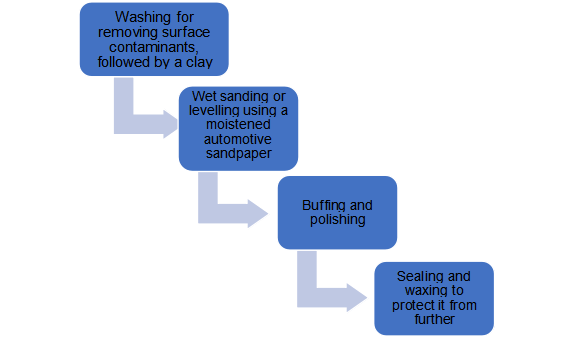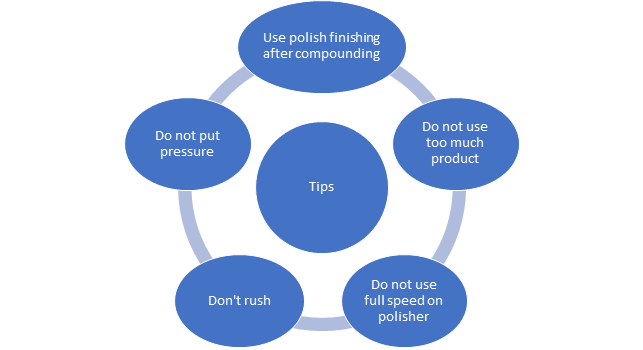
Have you ever noticed a spider web-like structure on a car standing in the sun? These are nothing but circular-shaped scratches that occur due to incorrect washing methods. Many people wash and detail cars with the old circular wax on and off technique. It is where the marks on the car come from.
It is primarily impossible not to mildly scratch the car’s surface during a wash. The circular movements cause scratches in the paint. Indeed, car scratches are every car owner and detailer’s worst fear.
You will find scratches everywhere, and the harder you try to remove them, the more they are left. On observing closely, the scratches reveal deep gaps that penetrate through car paint’s various layers.
When light hits a scratch, all it does is bounces all around and reflects at a different angle than the surrounding smooth surface. The marks look ugly and damage the paint on leaving untreated. Here comes the importance of paint correction.
Here is a blog that will give detailed insights on paint correction.
What is paint correction?
Paint correction is the process that involves restoring and rejuvenating the car’s paintwork. It includes eliminating the surface’s imperfections that make it dull, hazy, or oxidized by reflecting light off it in several directions.
The reasons for these mainly include fine scratches, swirl marks, bird dropping etching, acid rain etching, and random isolated deep scratches.
A car is treated with touch-up paint, multi-stage polishing, refinishing, and coating. The corrective process involves removing a small amount of clear paint or coat from the car’s surface using abrasive polishes. These are applied with polishing machines to level out the surface.
Do you know that a car that looks well taken care of will look muddled because of ‘orange peel’? It occurs when a paint’s finish is similar to the texture of an orange. It occurs due to lack of finishing procedures, improper paint, and machine spray.
Does paint correction remove car coating?
Yes. The polishing process involves a gritty substance known as a cutting compound. On activating the electric polisher, the liquid polish or paste is spread evenly on the car’s painted surface. It causes friction that cuts through the paint’s clear coat.
The polishers are made in multiple grit levels to fill either a scratch or remove the clear coat until the scratch is removed. If you cut the clear coat thin, then it will be challenging for the protective coating to bond with the car’s surface.
Is car paint correction worth it?
If you care about your car’s longevity and appearance, then having paint protection is worth it. It is the best way to make the car stand out in the crowd. Paint correction is the right way of making your car’s paint incredible. However, you should do the paint correction only to the level that you can maintain.
Did you know that powerful UV rays beat down the clear coat on a car standing outside in the sun, leading to oxidation? Here, paint correction becomes technical, and a professional detailer can bring optimal results.
How long does paint correction take?

Paint correction involves 5-30 hours based on the process that you adopt. It is not a fast or straightforward procedure to accomplish. It mainly involves four steps.
Do you know what happens when the car paint’s clear coat is damaged? It will take lesser time for the debris and dirt to penetrate the car’s surface and damage the pigmented basecoat.
Here are some paint correction tips

- Making use of a high quantity of the product will not ensure better results. The only thing that will give you the desired results is spreading the product on the car surface everywhere.
- Try to use only that much product that is either needed or instructed on the label. Generally, 3-5 dots of polish are enough for one section.
- Do not use full speed on the polisher. Increasing the speed will raise the chance of burning the paint, especially on using the rotary polisher.
- Try not to rush and go slowly. Whenever you rush, you are not giving the polisher enough time for correcting the paint defects. Go slow so that polish and pad will get enough time to remove imperfections, cut the paint, and bring back the original shine and gloss.
- Do not put immense pressure on the polisher. Do not assume that by putting more pressure, the job will get done in lesser time. Instead, it will damage the paint. Choose suitable pads and polishes to fix paint imperfections.
- Ensure using finishing polish after compounding. If you do not use an all-in-one product that polishes and compounds, then it is good to use a finishing polish after compounding. It will give the paint a glossy finish.
Conclusion
So, synthetic car paint sealants and wax have been the traditional methods for protecting the car’s paint. Modern technology has introduced improved methods like car paint correction that involves saving the paint from swirls and scratches. Investing appropriate time and money will help you get a proper car paint correction.
